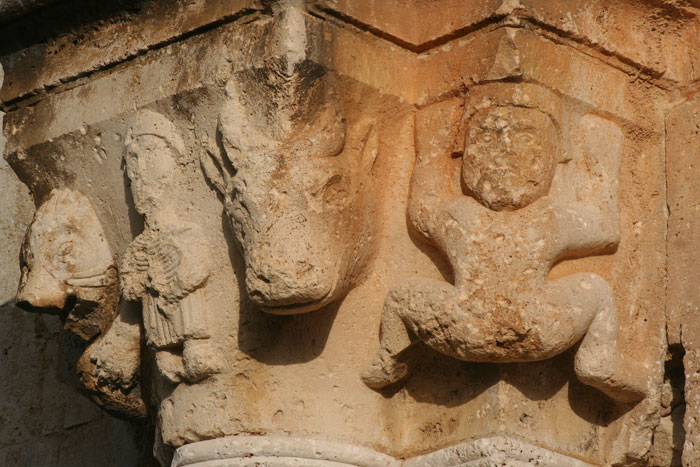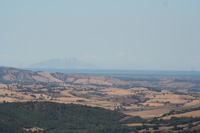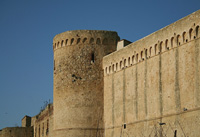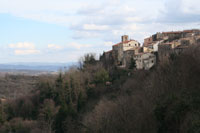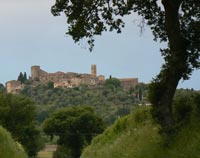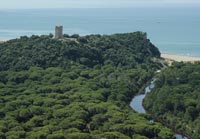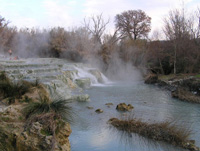| |
|
|
The Saint John Baptist Church was built during the Middle Ages and today it shows a particular fusion of different styles as a result of the numerous restorations made along the centuries.
The facade of the church shows some Renaissance elements whereas along its left side it is possible to admire some little windows showing a typically Gothic style. By its right side rises an imposing belfry ending in a cusp.
The interior of the Saint John Baptist Church has just an aisle and its roof is supported by archs resting on Romanic columns, showing this latter decorated capitals.:
In the zone of the apse there are a tabernacle dating back to the XIII-th century and a travertine-made baptismal font dating back to the XV-th century. On the lintel it is possible to admire the ensign of the local community showing the name of its creator, M. Nicholaus, in Gothic letters.
|
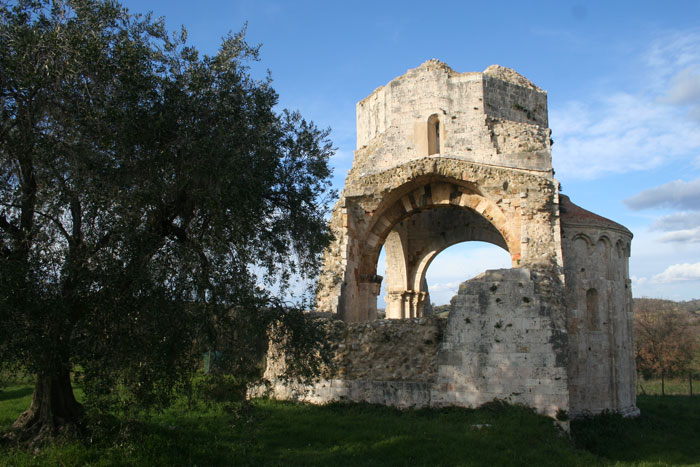 |
Monastero di San Bruzio
|
From Magliano in Toscana, take the road back to the intersection for Marsiliana and head left (the only way). Not far from the intersection, on your left you'll see the remains of San Bruzio monastery.
This religious settlement was an important presbitery, remembered since the 13th-14th century. Between its walls were offered hospitality at the old priests of the local diocese: they started a commonlife, like a kind of monastery. Today survives the rests of the presbiterial part, with the central apse, two wings of the transept and the octagonal foundation of the Dome (Cupola).
|
| The architecture of S.Bruzio remember closely the Lombard style of the northern Italy, but in some particulars - the decorations of the abside, the column capitals and the lightness of its global form - we can see the developement of a primordial Gothic style. In the scarces rests we can still admire many sculptures and other fine carved furnishings.
|
|

|
| |
|
|
|
|
|
| |
|
|
| |
|
|
|
|
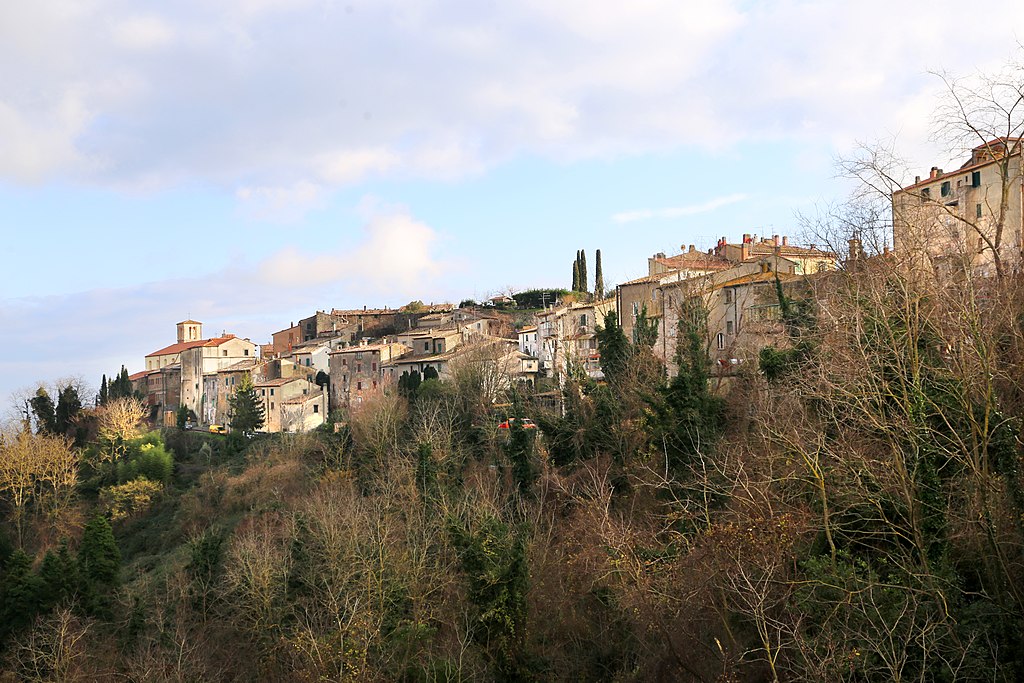 |
|
|
View from terrace with a stunning view over the Maremma and Montecristo
|
|
Scansano, veduta
|
Map Monastero di San Bruzio
|

Magliano in Toscana
During the XI-th century the territory of Magliano in Toscana was under the jurisdiction of the Aldobrandeschi's Counts who made a castle erected, whose around the community of Magliano in Toscana gathered building the first houses.
Along the next centuries the castle of Magliano in Toscana passed first to Bernardino di Magliano, an Aldobrandeschi's vassal, and then to the Aldobrandeschi's family of the Santa Fiora branch.
From the XIII-th century Magliano in Toscana was quarreled between the new Lords and the Republic of Florence, subduing political and military conflicts and their alternating to the power.
During the same period the territory of Magliano in Toscana subdued a siege by the English troops of the commander John Hawkood, after which the inhabitants started the fortification of the village by building a ring of walls equipped with towers.
The situation of political and economic instability lasted up to the middle of the XV-th century, when the Republic of Florence put to end the ancient quarrel by conquering and annexing Magliano in Toscana to its countryside.
Entered the orbit of the Medici's Grand Dukedom, Magliano in Toscana was gave as a feud by Cosimo I of Medici to Cornelio Bentivoglio, who was general of the Medici's troops. His family held the property of the village up to the XVIII-th century.
Later the Lorena's Dukes came to the power of the Tuscany. They gave to the village of Magliano in Toscana its autonomy and the opportunity to give itself own statutes.
The Lorena's domination lasted almost uninterruptedly up to the Unity of Italy occurred on 1861 by the action of the King Vittorio Emanuele II of Savoia.
Among the most important monuments to see in Magliano in Toscana we point out here the Chiesa di San Martino (SaintMartin Church), the Chiesa di San Giovanni Battista (Saint John Baptist Church), the Chiesa dell'Annunziata (Our Lady's Annunciation Church), the Palazzo dei Priori (Priors' Palace), the Palazzo di Checco il Bello (Palace of Checco the Handsome) and the Centro di Documentazione Archeologica (Centre of Archaeological Documentation).
Among the numerous celebrations periodically taking place in Magliano in Toscana we remind here the traditional festival called "Primizie di Vinellando" held yearly on March and during which it is possible both to taste good local wines and fine typical courses and to visit the interesting close archaeological sites.
|
 |
|
 |
|
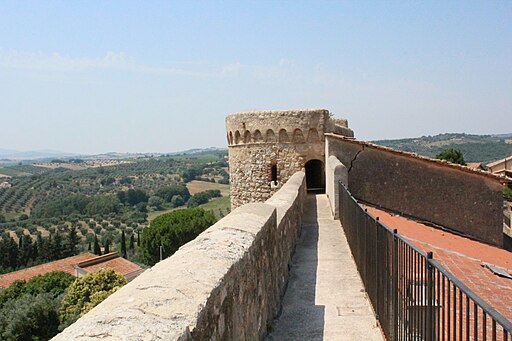 |
Particolare del giro delle mura
|
|
Mura di Magliano in Toscana |
|
Mura di Magliano in Toscana |
| |
|
|
|
|
The Castle of Montepò
The Castle of Montepò, a massive and still intact fortress, was built around the year 1000 near an ancient parish church. The castle has been entirely reconstructed in the 14th century when it was under the control of the lords of Cotone.
In 1530 the castle was the object of an architectural makeover by the Sienese military architect Baldassarre Peruzzi, who substituted the crenellations of the towers and walls.
Today, the Castle of Montepò is represented as a splendid and rare example of a Sienese fortified villa of the late 15th century.
The castle today belongs to the Biondi Santi family, and is an integral part of their farm specializing in the production of excellent wines. Previously it was the place used to inspire the British writer Graham Greene. The castle is not open to the public.
Manciano
Manciano rises on the top of a hill open to the four winds, with a breathtaking view in all directions: from the Amiata to the Fiora valley, from Talamone to the beaches of Montalto di Castro, from the Argentario to the Islands of Giglio and Montecristo.
It is a mysterious and enchanted spot. It’s not by accident that it is remembered with the saying, “Manciano delle streghe, dove si va si vede”, “Manciano, home of witches, wherever you look, you see them”.
The area around Manciano was settled in prehistoric times as demonstrated by the archeological findings near Saturnia, Marsiliana and Poggio Murella.
Manciano was ruled in the 12th century by the Aldobrandeschi family and then later by the Orsini Counts from Rome.
However, its geographical position and solid walls didn’t prevent its being conquered in 1461 by the Siena Republic which then built a fortress overlooking the vast panorama.
|
|
|
|
|
|
|
|
|
|
|
| |
|
|
|
|
Trekking in Toscana | Percorso ad anello | Polveraia - Belvedere Montorgiali Montepo | 17 km
Anello Bivio Montorgiali - Montorgiali - Preselle | 22?5 km
Da Saturnia a Poggio Murella, a San Martino sul Fiora | 12,6 km
|
Saturnia
Another spot of interest is Saturnia, considered by some to be the craddle of Italian civilization, with an Etruscan, Roman and Medieval past.
Under the history of Saturnia are profoundly ancient roots, in fact we know that the area where today’s Maremman town is, was first inhabited by the Etruscans. In the course of the following centuries, it became an important Etruscan dominion, which could then boast great significance and importance under the control of the Roman Empire.
In fact under the Romans, the city experienced a great period of development, profiting from its extraordinary vicinity to Via Clodia and from the creation of primitive public sulfuric baths. During the Middle Ages it was assisted by the domination of the Aldobrandeschi and the Orsini but experienced a period of great debauchery, with numerous popular legends surfacing around thermal waters.
Many believed the sulfuric waters were really the waters of hell. Only during the 18th century did the fortune of the Tuscan city begin to change, thanks once again from interest by medics and scholars who began to preach about the curative properties of the waters.
However, even more than its history, it is known for its hot sulfur springs, which gush forth all year at a temperature of 37.5°C.
Montemerano
Montemerano is a picturesque walled village situated on a beautiful hilltop. Montemerano maintains the look of an ancient medieval castle with it’s antique streets and quaint, charming houses. The 14th century Chiesa di San Giorgio is located in the highest part of the historical centre. It is a splendid example of Romanic architecture and houses one of the most important artistic patrimonies in the province of Grosseto. The church houses an important 15th century polyptych and the Virgin of the Gattaiola, or The Virgin of the Cat Flap.
The Church of St. George stands out, above all, because it houses the works of two of the most important 15th century Sienese artists: the sculptures of Vecchietta and an altarpiece by Sano di Pietro.
Montemerano is close to Manciano and is well worth a stop.
|
| Magliano in Toscana
|
|
|
|
|
|
|
|
|
|
Parco Naturale della Maremma
The most famous part of the Maremma is the Parco Naturale della Maremma, otherwise known as the Parco dell'Uccellina
|
|
Saturnia
Saturnia is also famous for its sulfuric spring with waters which offer important curative properties.
|
| |
|
|
|
|

From Magliano in Toscana to the Abbey of San Bruzio
Trekking route - The itinerary to the ruins of the Abbey of San Bruzio starts from Magliano in Toscana. Time needed to make the route is about 30 minutes, elevation 66 meters.

33. La bassa valle dell’ Albegna | The Lower Albegna Plain - 89 km
ORBETELLO - STRADA DI CAMERETTE - ANSEDONIA (COSA ) - OASI WWF LAGO DI BURANO - CHIARONE SCALO - GARAVICCHIO (GIARDINO DEI TAROCCHI) - BORGO CARIGE - CAPALBIO - MARSILIANA - MAGLIANO IN TOSCANA - QUATTROSTRADE - ORBETELLO SCALO - ORBETELLO

Podere Santa Pia is a peaceful retreat, perfect for relaxing and enjoying the splendor of the Tuscany countryside. Enjoy the exquisite art, museums and churches in the nearby cities, then relish the cuisine and epic countryside. Podere Santa Pia highlights the best of the quintessential Italian region.
Hidden secrets in Tuscany | Holiday house Podere Santa Pia
|
| |
 |
Casa vacanze Santa Pia is perched atop the Maremma hills about 35 km from the coast and just 22km from the Brunello di Montalcino area of Tuscany. The location of Podere Santa Pia is unique and the landscape a once-in-a-life sight. Set in the historic area of the Maremma Santa Pia offers evening views up to the Tyrrhenian coast, the island Montecristo and on clear evenings even Corsica.
|
|
|
|
| |
|
|
